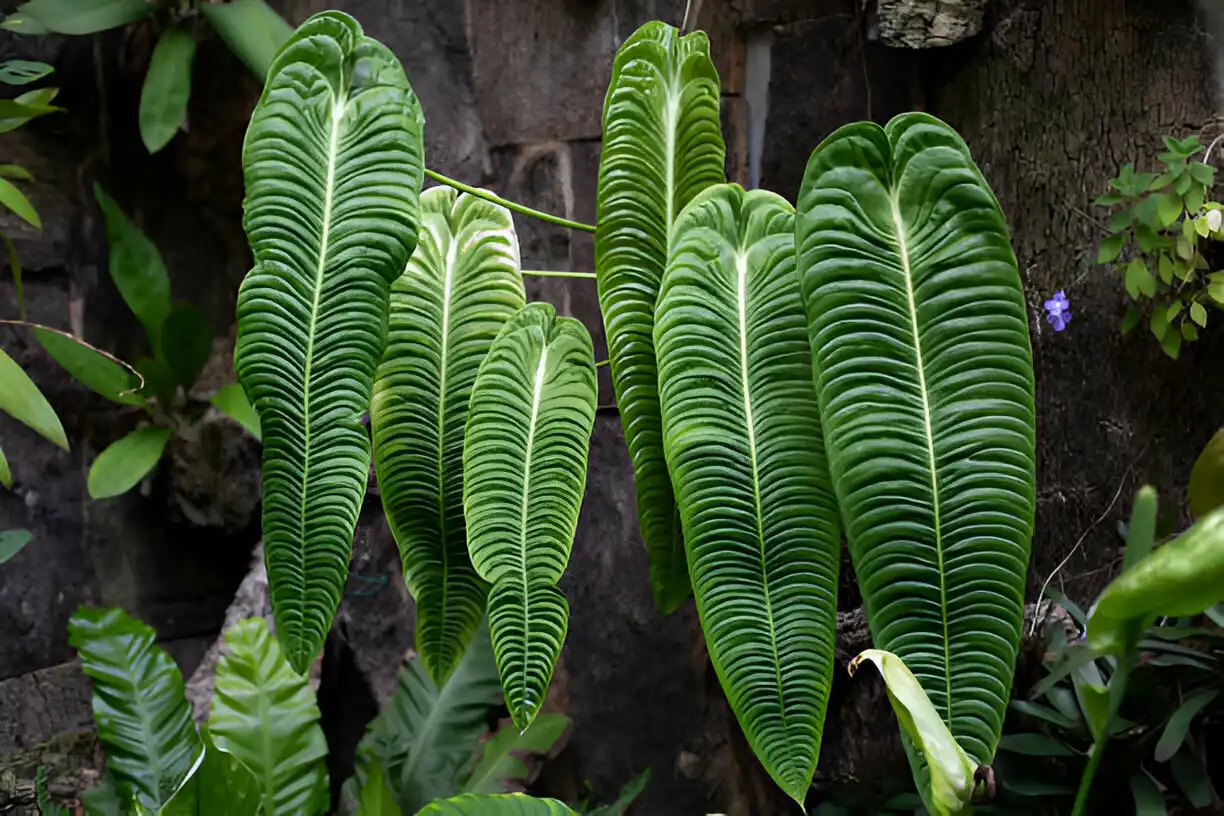Introduction
Anthurium Veitchii, commonly known as the King Anthurium, is a mesmerizing plant celebrated for its stunning foliage and exotic flowers. Its elegant appearance has made it a favorite among plant enthusiasts and collectors worldwide.
Quick Overview
| Common Name | King Anthurium |
| Scientific Name | Anthurium Veitchii |
| Sun Exposure | Partial |
| Soil Type | Well-Drained |
| Soil pH | Acidic |
| Family | Araceae |
| Mature Size | Up to 2-6 Ft. Tall, 3-4 Ft. Wide |
| Plant Type | Herbaceous, Perennial |
| Native Area | Colombia |
| Toxicity | Toxic to Dogs, Cats, Horses And Peoples |
Origin and Natural Habitat
Native to the rainforests of Central and South America, Anthurium Veitchii thrives in the humid and shaded environments of its natural habitat. It is often found growing on trees, with its roots clinging to the bark, absorbing nutrients and moisture from the air.
Unique Features of Anthurium Veitchii
Foliage
One of the most striking features of Anthurium Veitchii is its large, heart-shaped leaves that can grow up to several feet in length. These glossy, dark green leaves have prominent silvery-white veins running across them, adding a touch of elegance to the plant.
Flowers
The flowers of Anthurium Veitchii are equally captivating, featuring a bright red spathe that encloses a slender, creamy-white spadix. These long-lasting blooms add a burst of color to the plant and can make any space come alive.
Types of Anthurium Veitchii
Anthurium Veitchii offers several captivating varieties, each with its unique features:
- King Anthurium: Standard variety with large, heart-shaped leaves and bright red spathes.
- Silver King: Known for its silvery-white veined foliage, creating a shimmering appearance.
- Giant Form: Features larger leaves and flowers, making it a standout in any space.
- Variegated: Rare variety with variegated foliage, adding extra visual interest with patches of lighter green or white.
- Miniature: Compact variety ideal for small spaces, retaining the stunning beauty of Anthurium Veitchii in a smaller size.
Each type offers distinct characteristics, allowing you to choose the perfect Anthurium Veitchii to enhance your indoor garden.
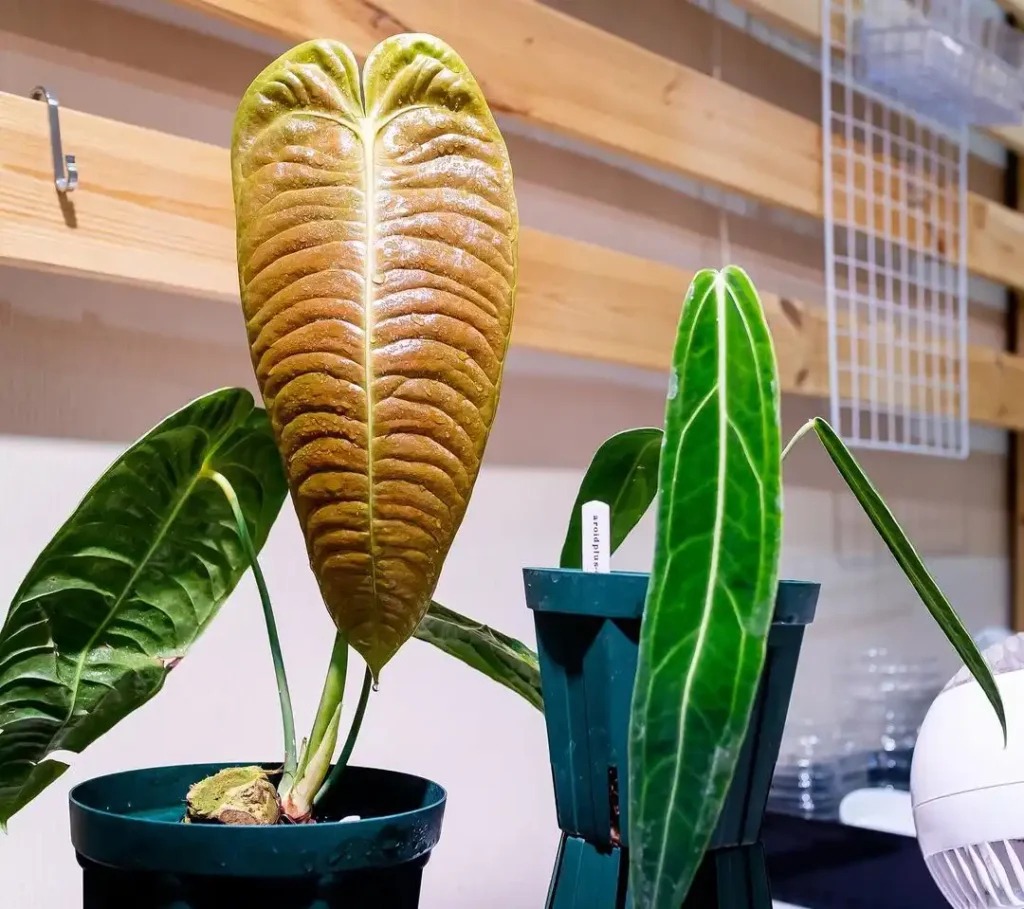
Read Me – Alocasia Sarian: The Ultimate Care And Growing Guide
Caring: Nurturing For Your Leafy Companion
Embarking on the voyage of Anthurium Veitchii guardianship unveils an enchanting realm of attentive devotion and insight. Navigate this intricate landscape with finesse using our curated guide to sustain the exuberance and vitality of this magnificent plant:
Watering
Anthurium Veitchii revels in a nuanced quench, cherishing soil that remains uniformly damp but not saturated. During watering escapades, facilitate the egress of surplus moisture and await the desiccation of the superficial soil stratum before bestowing another libation. This methodology ensures ample hydration sans the risk of root submersion.
Light Requirements
Conceive your Anthurium Veitchii as an aficionado of subdued luminosity. Situate it within an area suffused with luminous, diffused light, akin to the ambiance near a window draped in diaphanous curtains. Safeguard it from the harsh glare of direct solar beams to avert foliage scalding, preserving its resplendent countenance.
Humidity
Incorporating its equatorial lineage, Anthurium Veitchii flourishes amidst a sultry milieu. Endeavor to sustain humidity thresholds between 60-80% by sporadic leaf misting or positioning a water-saturated pebble receptacle in proximity. This emulates its native milieu, fostering a sense of belonging and well-being.
Fertilization
Nourish your Anthurium Veitchii during its verdant expansion phase, spanning from the vernal to estival seasons, employing a diluted, equilibrated aqueous nutrient. Grant it a hiatus during the hibernal season, enabling a phase of repose and invigoration devoid of supplemental nourishment.
Trimming Rituals
Analogous to shearing frayed termini, episodic grooming accentuates the aesthetic allure of your Anthurium Veitchii. Excise any moribund or jaundiced foliage and faded blossoms utilizing sterile, keen-edged shears. This regimen not only augments its aesthetic allure but also catalyzes robust proliferation.
Temperature
Sustaining an equable thermal spectrum between 65-80°F (18-27°C) engenders contentment and flourishing in your Anthurium Veitchii. Sidestep exposure to mercurial thermal extremities, as such fluctuations could induce stress, compromising its vigor and vivacity.
By assimilating these care tenets, you’ll nurture a symbiotic rapport with your Anthurium Veitchii, venerating its singular elegance and reveling in the invigorating aura it imbues within your abode.
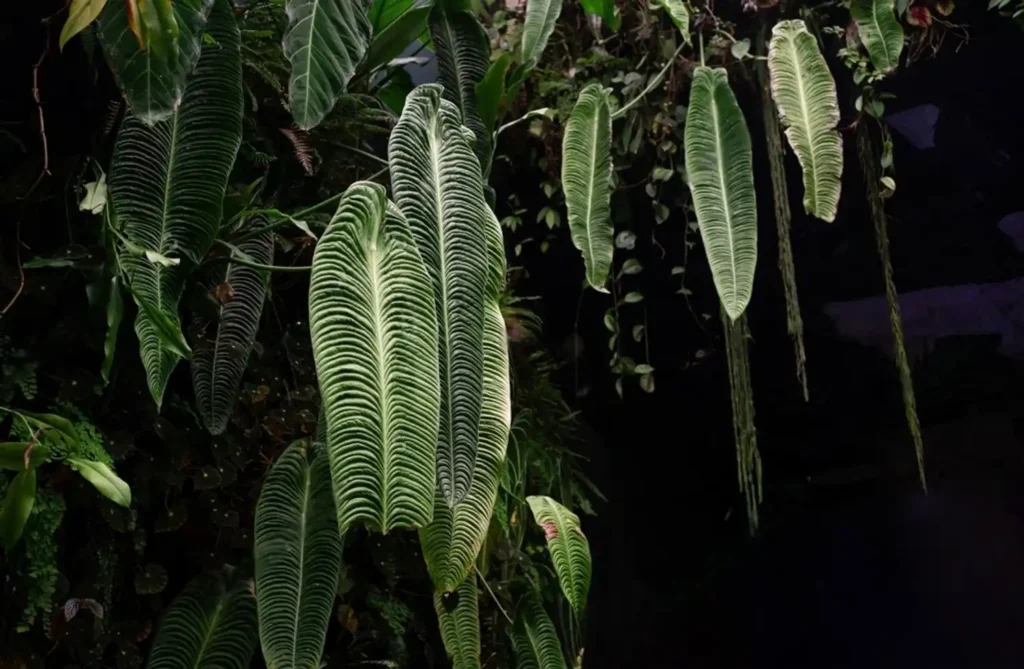
Propagation: Cultivating Your Anthurium Veitchii
Do you find yourself enamored with Anthurium Veitchii, harboring aspirations for an opulent assemblage? Your horticultural journey towards expanding your Anthurium Veitchii collection through propagation is an endeavor teeming with anticipation and satisfaction. Let us delve into two captivating methodologies: division and stem cuttings.
Division: The Elegance of Segmentation
As your Anthurium Veitchii matures, its robust growth may necessitate an expansion of its habitat. Allow me to elucidate the meticulous process:
- Liberating the Plant: With utmost care, extract your Anthurium Veitchii from its container, delicately dislodging the soil to unveil its elaborate root network.
- Identifying Natural Partitions: Seek out inherent divisions or segments suitable for gentle separation. Each segment ought to possess its own stem and a modest portion of root to bolster its development.
- Surgical Separation: Employing pristine, keen-edged scissors or shears, judiciously sever the roots to create distinct segments. Ensure each segment harbors a robust stem and root structure conducive to its vitality.
- Transplanting the Segments: Nestle each novel segment in an individual receptacle replete with permeable soil. Administer a liberal watering and position them in a snug locale bathed in soft, indirect luminescence.
Stem Cuttings: Cultivating Fresh Initiatives from Stems
Possessing a dynamic Anthurium Veitchii stem heralds a new chapter in your botanical odyssey! Here’s your guide to metamorphosing that stem into a nascent plant:
- Electing Your Stem: Discern a sturdy stem adorned with at least two nodes, the minuscule points of growth where leaves or branches emerge.
- Executing the Incision: Utilize your sharp implements to truncate just beneath a node on the chosen stem.
- Refining Your Cutting: Strip away the basal leaves, retaining only a sparse cluster at the apex. This strategy facilitates the cutting’s concentration on root development.
- Embedding Your Cutting: Immerse the severed extremity of your stem into a petite container brimming with damp, permeable soil. Gently compact the soil to stabilize the stem.
- Crafting an Optimal Environment: Position your potted cutting in a temperate, humid milieu suffused with ample, indirect luminosity. Maintain a consistently moist soil environment, steering clear of saturation.
- Observing Emergence: Maintain vigilant surveillance over your cutting, awaiting indications of burgeoning growth. The emergence of fresh foliage signifies successful acclimatization!
In conclusion, whether you opt for division or embark on the path of stem cuttings, the propagation of Anthurium Veitchii unveils a gratifying exploration, fostering fresh growth and cultivating your botanical family with heartfelt dedication. Enjoy your gardening endeavors!

Potting and Repotting: Revitalizing Anthurium Veitchii’s Habitat
Delving into the realm of plant care, potting and repotting serve as pivotal stages, fostering Anthurium Veitchii’s well-being and vibrancy. Let’s traverse this enriching expedition of botanical nurturing.
Formulating an Optimal Potting Mixture
Envision crafting a sanctum for Anthurium Veitchii. Selecting an impeccable potting blend equates to orchestrating a concoction that’s both enriching and bolstering.
Commence with a fusion of peat moss, perlite, and a modicum of orchid bark. This amalgamation fosters an amicable milieu, assuring the roots luxuriate in a harmonized space, facilitating respiration and nutrient absorption.
Potting: Laying the Cornerstone
Embarking on the journey to bestow a novel dwelling upon Anthurium Veitchii, prioritize a receptacle endowed with apt drainage, safeguarding the plant’s roots from superfluous dampness. Situate Anthurium Veitchii centrally, meticulously splaying its roots. Populate the receptacle with your bespoke soil blend, delicately compacting it for foundational robustness.
Repotting: Embracing Expansion
As Anthurium Veitchii matures, it might intimate its aspiration for an augmented expanse. If you discern roots protruding from the drainage apertures or the plant appearing snug, the moment beckons for a repotting endeavor!
Navigate through this compass:
- Choose an Expansive Receptacle: Ponder upon it as transitioning to a grander chamber. Anthurium Veitchii will relish the supplementary space to unfurl its roots!
- Graceful Transference: Meticulously reposition your plant to its fresh receptacle. Delicately dispel the former soil and disentangle any root entanglements.
- Emerging Horizons: Position Anthurium Veitchii within its newfound sanctuary, incorporating fresh soil to anchor it. Bestow a liberal irrigation to inaugurate its extended domain.
Post this transition, allocate a respite for Anthurium Veitchii to acclimate. Refrain from fertilization for several weeks, permitting it to harmonize with its rejuvenated surroundings.
Consistent repotting every 1-2 years propels Anthurium Veitchii towards sustained vitality and exuberance, poised to unveil its mesmerizing foliage and blossoms!
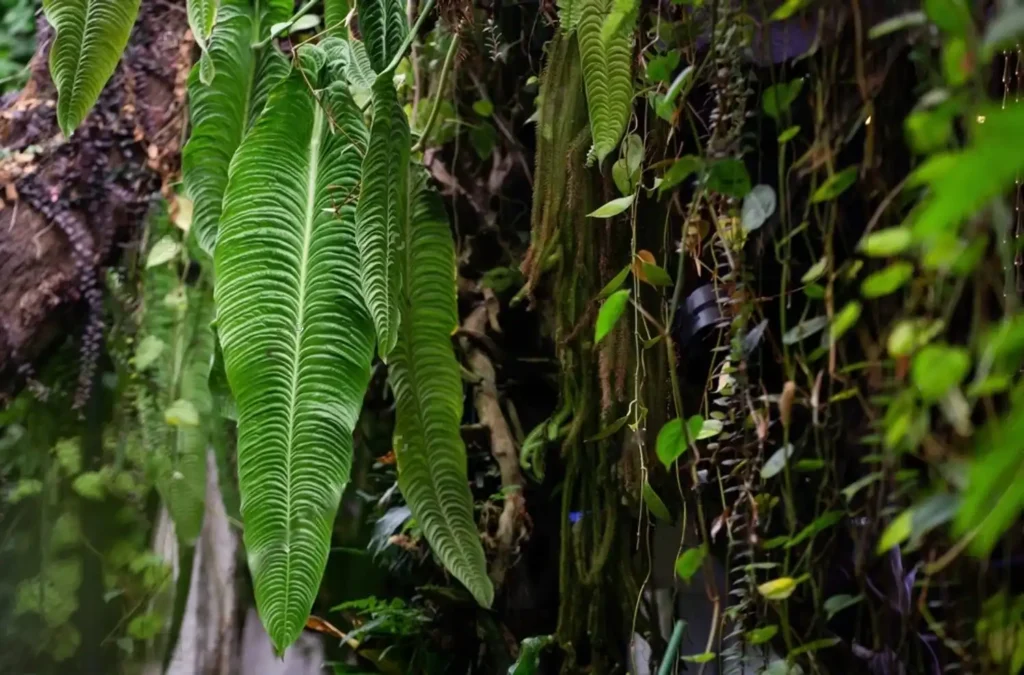
Pests & Diseases: Navigating Challenges with Anthurium Veitchii
Anthurium Veitchii, a plant of mesmerizing allure, occasionally grapples with unwelcome guests and health issues. Let’s delve into the potential adversaries and maladies that could afflict this splendid specimen and discover ways to preserve its well-being.
Intruders of the Green Realm: Pests
Our Anthurium Veitchii may face encounters with minuscule trespassers:
- Aphids: These diminutive entities relish indulging in the succulent essence of Anthurium foliage. They congregate beneath the leaves, inducing them to distort and lose their luster.
- Mealybugs: These fluffy invaders can deplete the energy from our Anthurium, resulting in leaf discoloration and stunted growth.
- Spider Mites: Despite their minuteness, these mites can wreak havoc by spinning intricate webs on the plant, compromising its vitality and aesthetics.
Health Hurdles: Common Diseases
Similar to any sentient being, Anthurium Veitchii can confront health impediments:
- Root Rot: Excessive irrigation can inundate our plant’s root system, culminating in root rot. This fungal affliction can induce leaf wilting and discoloration.
- Leaf Spot: This fungal ailment can mar the leaves with unsightly brown or black blemishes. It flourishes in moist conditions, making proper hydration essential.
- Botrytis Blight: This fungal manifestation presents as a grayish-brown velvety layer on the plant. It favors chilly, damp settings and can propagate swiftly.
Guarding Our Verdant Companion: Prevention and Nurturance
To ensure the flourishing of our Anthurium Veitchii:
- Vigilance: Routinely scrutinize your plant for indications of pest infestation or disease. Timely identification can thwart the exacerbation of the issue.
- Optimal Conditions: Guarantee that your Anthurium is provided with suitable luminosity, judicious watering, and optimal moisture levels. A conscientiously tended plant exhibits greater resilience to adversities.
- Maintenance: Promptly eliminate any deceased or compromised leaves and blossoms. This not only amplifies the plant’s aesthetic appeal but also diminishes the susceptibility to pests and diseases.
Should you discern any distress signals from your plant, organic remedies are at your disposal to efficaciously mitigate the concern. Always adhere to the prescribed application guidelines to uphold the vitality and vibrancy of your Anthurium Veitchii.
With diligent attention and preemptive actions, our Anthurium Veitchii can persistently flourish and captivate with its splendor!
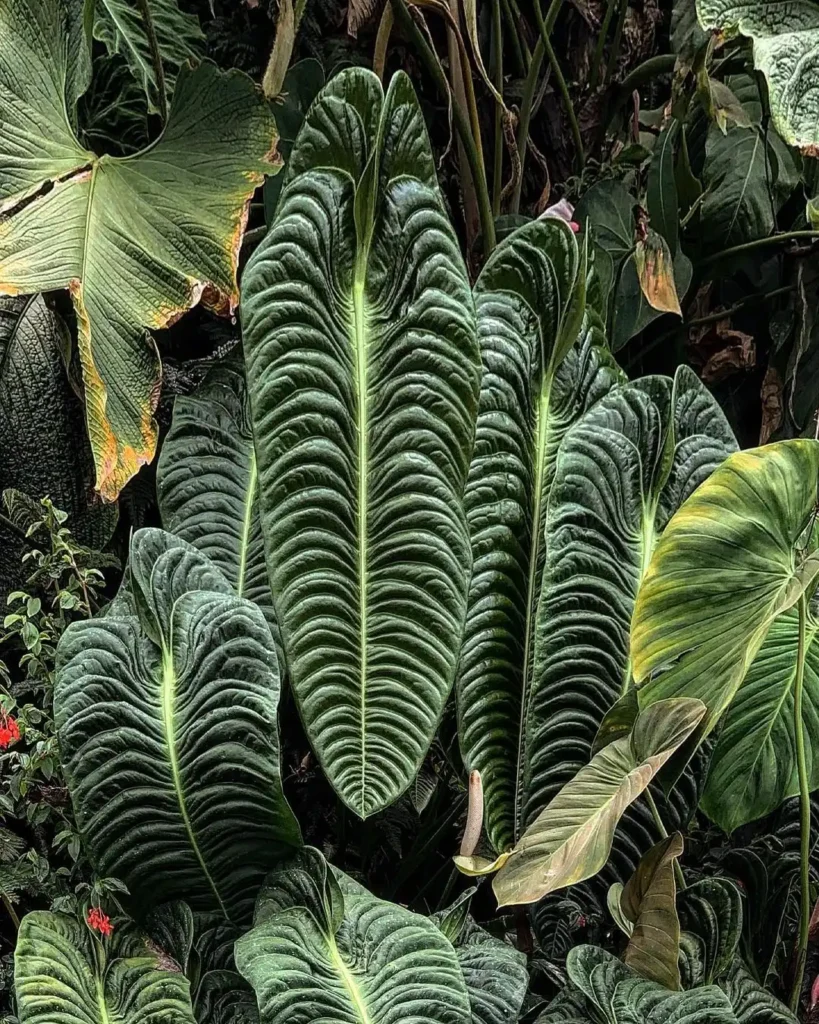
Common Problems: Everyday Issues with Your Plants
Anthracite Veitchii, the resplendent King Anthurium, is a captivating spectacle that demands reverence. Like an enigmatic relic, this botanical wonder carries its own labyrinthine challenges. Delve into these idiosyncrasies and uncover the secrets to preserving the grandeur of your Anthurium.
The Fading Brilliance of Leaves
Have you ever discerned a yellowish tinge adorning your Anthurium’s foliage? It’s akin to a diminutive beacon, subtly indicating a plea for nurturing. Often, this phenomenon arises from excessive hydration, saturating the roots. To rectify this, allow the upper stratum of the soil to desiccate slightly between hydration intervals and recalibrate your watering cadence.
The Enigma of Brownish Leaf Edges
The appearance of brownish edges on your Anthurium’s leaves can be perplexing. This typically signifies an arid atmosphere or an inconsistent hydration regimen. Anthuriums thrive in a humid milieu, so contemplate the integration of a humidifier or positioning a receptacle brimming with water and stones in proximity. Aim for a steady, restrained watering schedule.
Intruders of the Unwelcome Kind
Nuisances such as aphids, mealybugs, and spider mites occasionally perceive your Anthurium as a delectable banquet. Exercise vigilance for any clandestine activity or indicative manifestations like cobwebs or adhesive residues. Should they infiltrate, a mild rinse with insecticidal solution or organic pest deterrents can reinstate equilibrium.
Concerns of Fungal Origins
Excessive dampness coupled with insufficient air movement can foster fungal maladies like root degradation and leaf blemishes. Your Anthurium may subtly convey a desire for enhanced respiratory freedom! Opt for porous soil and permit the superficial layer to parch between hydration intervals. Employing a fan for augmented air circulation can prove advantageous.
Photosensitivity and Its Ramifications
While Anthuriums relish sunlight, direct exposure to fervent beams can occasionally be detrimental to their fragile foliage. Should you discern discoloration or indicators of solar-induced impairment, contemplate relocating your Anthurium to a location bathed in milder luminescence.
In Retrospect
Anthurium Veitchii, this botanical marvel, warrants our unwavering care and devotion. Though it may pose occasional quandaries, with perseverance and meticulous observation, you can facilitate the exuberant splendor of your Anthurium, ensuring its enduring allure!
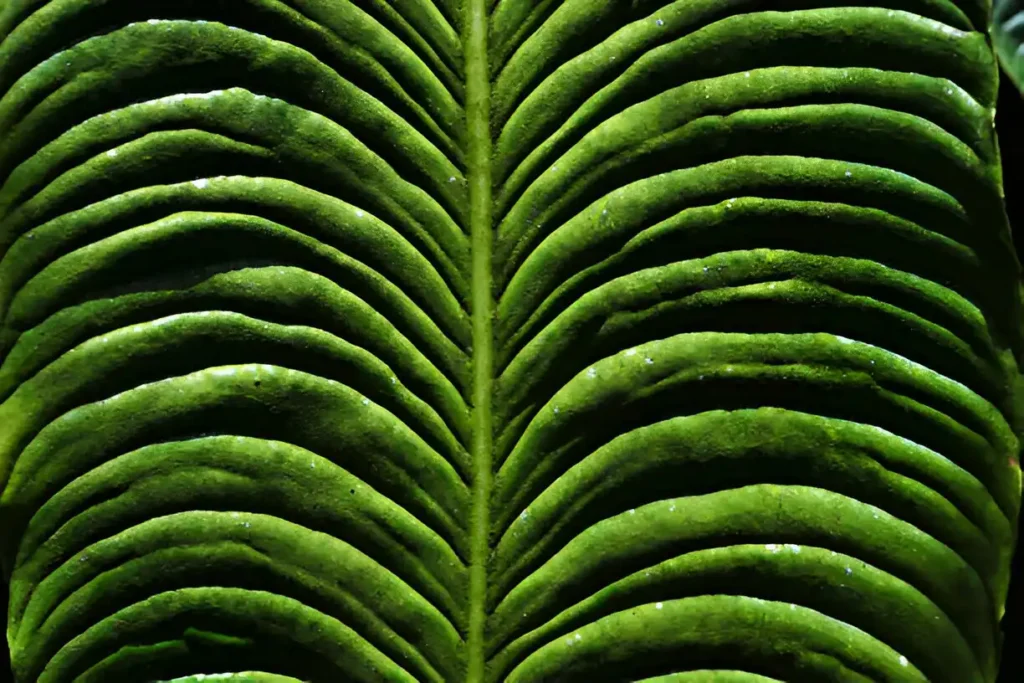
FAQs: Frequently Asked Questions
Is Anthurium Veitchii easy to care for?
Anthurium Veitchii, while stunning, does require specific care to thrive. It prefers bright, indirect light, well-draining soil, and high humidity. Proper watering is crucial; allow the top inch of soil to dry out between waterings to prevent root rot. With consistent care tailored to its needs, Anthurium Veitchii can be a rewarding plant to grow indoors.
How often should I water my Anthurium Veitchii?
Anthurium Veitchii thrives when watered thoroughly but infrequently. Check the top inch of the soil; when it feels dry to the touch, it’s time to water. Overwatering can lead to root rot, so it’s essential to allow the soil to dry out between waterings. Always use room temperature water, and avoid letting the plant sit in water to maintain its health.
Can Anthurium Veitchii tolerate low light conditions?
While Anthurium Veitchii prefers bright, indirect light, it can tolerate lower light conditions for short periods. However, extended periods of low light may result in leggy growth and reduced flowering. Placing the plant near a north or east-facing window is ideal to ensure it receives enough light without being exposed to direct sunlight, which can scorch its leaves.
Is Anthurium Veitchii toxic to pets?
Yes, Anthurium Veitchii is toxic to pets if ingested. It contains calcium oxalate crystals, which can cause irritation, drooling, and swelling in pets. It’s essential to keep the plant out of reach of curious pets and children to prevent accidental ingestion. If you suspect your pet has consumed any part of the plant, contact your veterinarian immediately for advice.
How can I increase humidity for my Anthurium Veitchii?
Anthurium Veitchii thrives in high humidity levels, ideally between 60-80%. To increase humidity, consider using a humidifier, placing the plant on a pebble tray filled with water, or misting its leaves regularly. These methods can help create a more humid microclimate around the plant, promoting healthy growth and preventing issues like brown leaf tips caused by low humidity.

